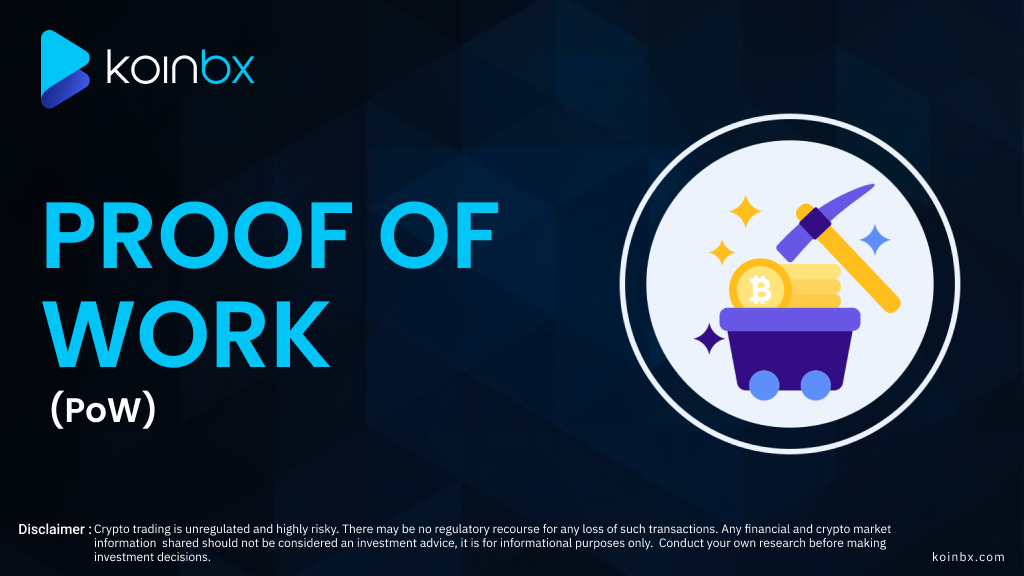Introduction
Proof of Work (PoW) is a consensus algorithm used by the majority of major crypto assets to prevent double-spending. Hence, it is referred to as a method of securing the crypto’s ledger.
PoW was the initial consensus algorithm to be introduced and is still the predominant one to this day. Although Satoshi Nakamoto introduced the concept of PoW in the Bitcoin white paper of 2008, the technology itself had already been developed prior to that date.
Adam Back's HashCash was one of the first Proof of Work algorithms to be implemented in the early days of cryptography. By requiring recipients to perform a relatively small amount of computational work prior to sending an email message, recipients could reduce the amount of spam that is sent. This computational work would be relatively inexpensive for a single legitimate sender, however, it would be costly for a large number of recipients.
PoW - Definition
On the other hand, crypto assets do not have any central authority verifying the veracity of new transactions or data that are uploaded onto the blockchain. Rather, they depend on a distributed Peer-to-Peer (P2P) network to verify incoming transactions and append them to the chain as new blocks.
PoW is a consensus algorithm that selects network members known as miners who are authorized to carry out the profitable task of verifying new information. It is profitable because miners are rewarded with fresh crypto when they verify the new information correctly and do not circumvent the system.
Bitcoin and other blockchains employ a software algorithm known as PoW to guarantee that blocks are only accepted as valid if they necessitate a certain amount of computing power. This consensus mechanism is designed to facilitate the trust between anonymous entities within decentralized networks, according to AmaurySechet, the founder of the eCash crypto.
PoW relies on miners competing with one another to solve specific mathematical puzzles in order to ensure that the system is not tampered with. The victor of the race is then chosen to add the most recent data or transactions onto the blockchain. However, the miners who win the race are only rewarded with the new crypto once other members of the network have verified that the data is valid and correct.
Also Read: Proof of Stake (PoS) Explained for Beginners: Your Go-To Guide
Significance of PoW
In 2008, the creator of Bitcoin, Satoshi Nakamoto, published a white paper outlining a PoW-based digital currency that would enable secure transactions between users without the need for a central authority.
In the past, one of the major obstacles to the development of a successful digital currency has been the issue of double-spending. As crypto is a data-driven system, there must be a mechanism in place to ensure that users do not spend the same unit in multiple locations before the system is able to record the transactions.
While it would be difficult to spend the same amount of money on two different purchases, anyone who has copied and pasted a computer file can likely imagine how they can spend digital money twice, or even ten times or more.
Working Mechanism of PoW
Cryptos are decentralized, meaning no central banks or financial institutions can guarantee trust. Rather, miners are responsible for ensuring transparent and accurate transactions through PoW. In the case of blockchains that rely on PoW, miners are the custodians and intermediaries that ensure the system operates efficiently and accurately.
The PoW mechanism necessitates that miners utilize computational resources for the purpose of obtaining the privilege. It is described below:
New transactions are aggregated together. Users can buy and sell cryptos, and the information from these transactions is aggregated into a block.
While processing the new block, miners compete with each other to become the first to successfully solve a complex mathematical problem. Demonstrating proof that they have completed the computational work—known as a hash—gives the miner the privilege of processing the block of transactions.
A single miner is selected to process the new block. The selection of the winning miner is subject to a level of randomness. The winning miner is rewarded with new crypto coins and initiates a new block on the blockchain.
CEO of Digital Asset Research explains that miners are incentivized to solve complex mathematical problems in order to earn a reward. These are labor-intensive tasks that necessitate a large amount of computing power and energy. As miners have invested considerable resources in computing equipment and energy costs, they are motivated to verify transactions accurately.
Advantages of PoW
In PoW, miners are required to pay a substantial amount of money for electricity in order to solve intricate mathematical problems and process a transaction on the network. This electricity is utilized to power the computers that generate digital assets by verifying transactions, referred to as mining. Furthermore, energy cost is essential for the security of the network, as it enables it to accurately record transactions and maintain a fixed, reliable monetary policy.
In addition, the network is safeguarded because fraud on the chain would necessitate a malicious actor to control 51% of the computing power of the network. When a blockchain is forked in a PoW system, miners must decide whether to migrate to the new forked network or continue to support the original blockchain.
For example, a miner would need to allocate computational resources to both sides of the fork to sustain both blockchains. Thus, by providing an economic incentive, Proof-of-Work systems naturally avoid constant forking and encourage the miners to choose the side that is not interested in harming the network.
These features are indicative of game theory, where miners must adopt a strategic approach to maximize their return on investment. Humans, like states of bounded rationality, will always opt for the most straightforward solution. Transitioning to a more complex chain can make the process more challenging. As a result, game theory assists oligopolies in avoiding internal corruption and making rational decisions.
Major Drawbacks of PoW
The use of proof of work systems has been the subject of considerable criticism, largely due to their excessive reliance on electricity.
Energy Consumption: The New York Times reported that in 2009, it was possible to mine one Bitcoin with a desktop computer and a relatively small amount of electricity. However, in 2021, it would take an amount of electricity equivalent to what a typical American household would consume in nine years in order to mine one Bitcoin.
Centralization: One of the most appealing aspects of crypto is its decentralized nature. However, due to the high computational and energy requirements associated with proof of work, mining activities have become concentrated in a few large companies. This could potentially result in a few entities dominating the majority of crypto transactions.
Also Read: Proof of Work (PoW) vs Proof of Stake (PoS)
Final Thoughts
PoW was originally developed to address the issue of double-spending and has since demonstrated its robustness and security. Bitcoin demonstrated that there is no need for centralized entities to ensure that the same funds are not spent twice. Through the application of cryptography, cryptographic hash functions, and computational game theory, users in a decentralized system are able to agree on the status of a financial system.
Download KoinBX Android App | Download KoinBX iOS App
Disclaimer: Any financial and crypto market information shared should not be considered investment advice. It is for informational purposes only. Conduct your own research before making investment decisions. Crypto trading is unregulated and highly risky. There may be no regulatory recourse for any loss of such transactions.






Comments